Day 25 April 12
The sun shone today, it was another of those blue-sky days. First thing, just after 7am Niall went up the mast to work on replacing the broken main halyard. I took a photo of him at the top of the mast and another photo of the whole mast. It is very tall at 31 metres and you need to look very hard to spot him at the top.
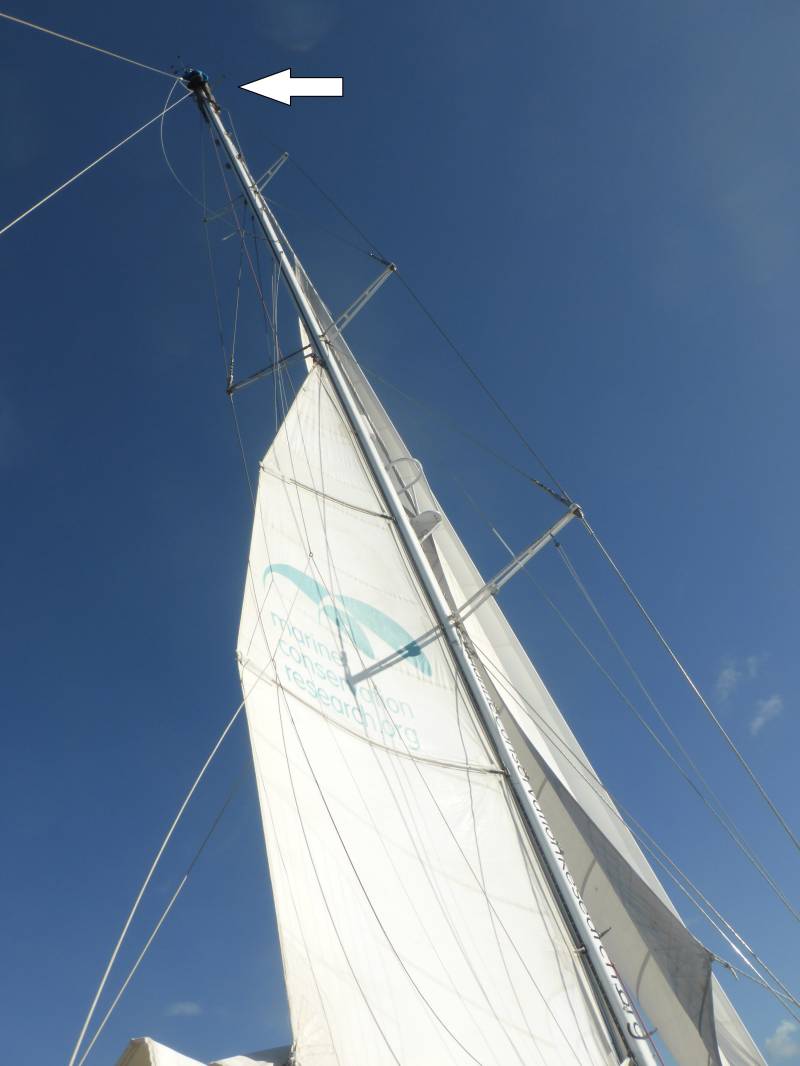
As you can guess, the boat sways a lot, up at the top of the mast the swaying must be magnified many times. Before Niall went up the mast the genoa was ‘backed’ – basically pulled onto the ‘wrong’ side of the boat. This has the effect of stopping the boat and so the swaying is much reduced. Before stopping the boat the 400 metres of hydrophone cable had to be pulled on board so it doesn’t get wrapped around the propeller or the rudder. It won’t touch the sea bed around here for we are in 5,000 metres of water.
Niall was up the mast for a couple of hours sorting it all out. Definitely a hero.
We set all three sails and headed onwards.
A Booby flew around us for a while in the afternoon. We haven’t seen many birds these last few days at all.
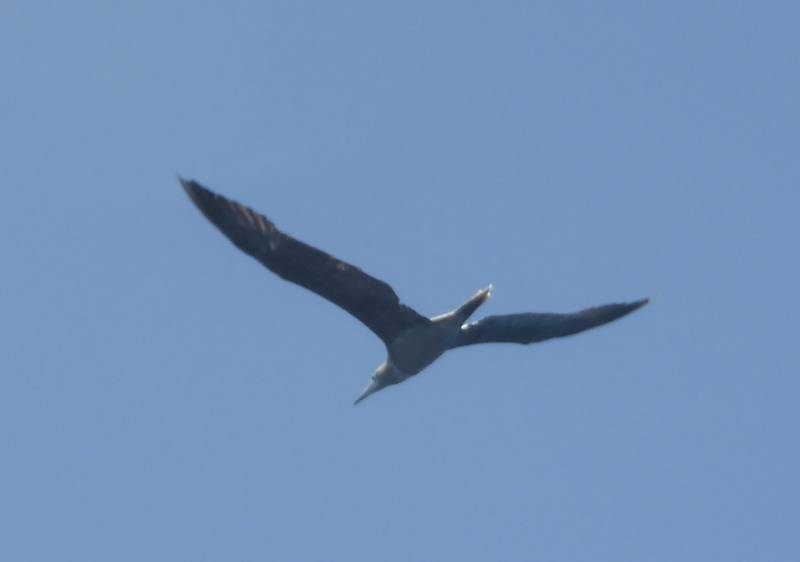
Day 26 April 13
Friday the thirteenth, unlucky for some, so they say. But it wasn’t unlucky for us. At 6.30am Claire spotted some whales. (Our clocks on the boat are set to Brazilian time and today the sun rose above the horizon a few minutes before 5am. (I know because I was up on deck).
We furled the two front sails, started the engine and motored over to them.
This boat has an amazingly quiet engine, it has been specially designed. We can hear the noise of a passing cargo ship that is ten miles away on the hydrophones. We cannot hear the noise of our own engine on the hydrophones which are only 400 metres away at the end of a cable.
We are able to get close to the whales without disturbing them.
There were ten sperm whales slowly swimming on the surface, continuously blowing spray in the air as they breathed. It was a wonderful sight for half an hour as we gently kept them on our port bow. Eventually they dived and we resumed course North East towards Africa and the Trade Winds. They were swimming on the surface in line together, peacefully with a couple of calves. They seemed to be just hanging about at the surface.
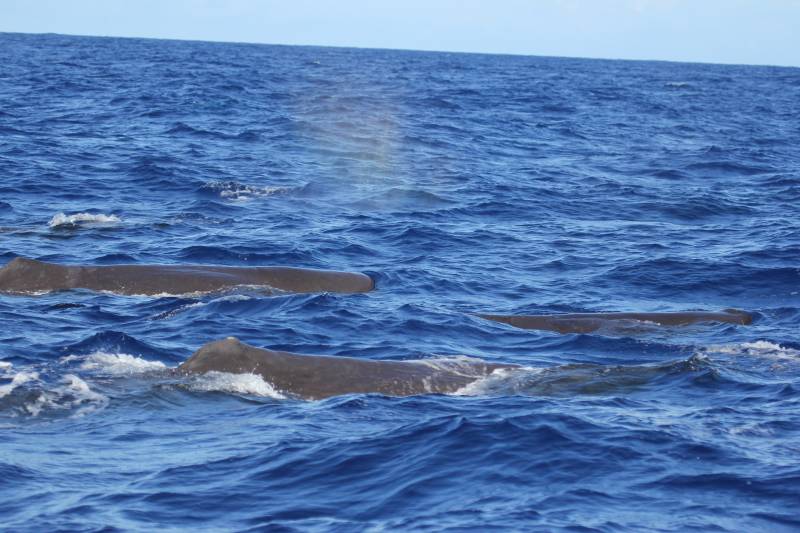
PS (from Claire) Although perhaps not the most photogenic of whale species, sperm whales are fascinating beasts. They carry out long foraging dives lasting over an hour to find the squid on which they feed. Sperm whales have been found to have different dialects of vocalisations, which are indicative of the area or population they are from. In fact, they are almost perfect for studying using acoustics as their loud clicks are easily distinguished from other species, almost continuous whilst the whales are diving, and loud enough that they can be heard up to 10km away. They are usually only found in deep water and we’ve been hearing them on and off since we left Salvador, so it’s nice to finally get a glimpse !
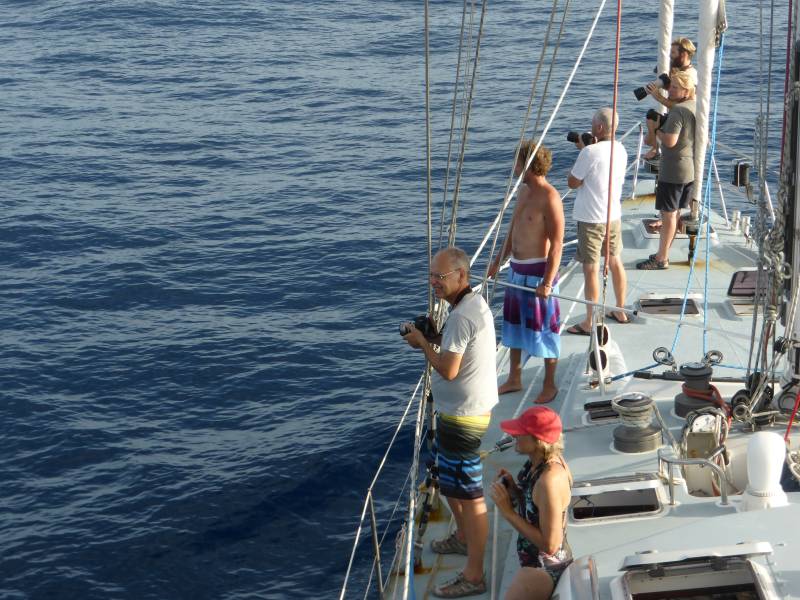
Day 27 April 14
When you are at sea for lots of days the daily round of eating, sleeping and washing continues but in very different ways. Washing water is not plentiful so dishes are cleaned in the minimum amount of water and showers are restricted to alternate days. The fact that we have any showers at all is wonderful, this boat can convert sea water into fresh water (using a process of reverse osmosis).
We do have a washing machine but this cannot be used if the boat is heeling so it only gets used in port. Clothes washing is done by hand.
Sleeping is not much of a problem. We all seem to sleep OK. Maybe it is the fresh air. I suspect the constant adjustments that the body has to make to counter the roll and pitch of the boat consume more energy than you would think.
Eating is not a problem either. There is plenty of food with a bread maker and a fridge. The fresh vegetables will not last many more days now but there are plenty of tins left and we are nowhere near through the cheese supplies.
Cooking food can be very tricky in a rough sea. Place a bowl of something on a work surface and you can find it scooting out of reach on the next roll. You also find yourself being flung across the galley at the most inconvenient of times. Great care needs to be taken with the sharp knives as we all are wearing sandals in this weather and a sharp roll can send a carelessly placed knife onto the floor. Several of the knives have bent tips!
The dining table is next to the galley and it gets very hot down there so we have been eating up on deck. It is a shame because the seats around the dining table are very comfortable. If you lift up the seats around the dining table a treasure chest of food is revealed. There is food stashed away behind all those cushions. There is plenty to choose from!
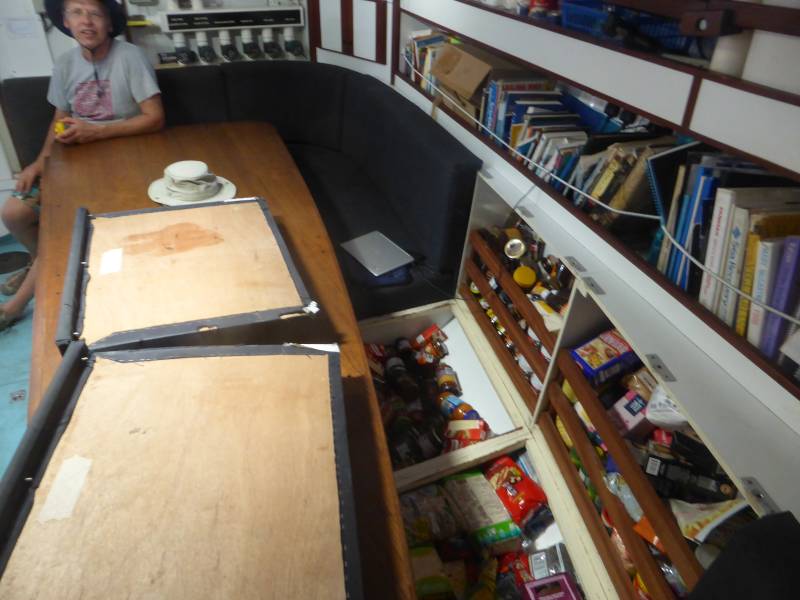
Day 28 April 15
It is Sunday today, a day of rest according to tradition. Of course Sunday is the same as any other day here, the boat doesn’t stop and we are on watch 24 hours. It was another sunny day, blue sky, steady winds. Just the type of day for relaxing and taking it easy.
A few big splashes were spotted off the port bow but despite sailing in the that direction we could not find any traces of any whales.
There is no chess board here on the boat however there is a laminator. A makeshift chess set was produced by laminating some paper to make a board. We racked our brains for ideas for making pieces. How on earth would they stay in place on a rocking boat? The simple solution is to use two whiteboard markers to write on the ‘board’. K stands for king. N stands for knight. Otherwise it would be very confusing!
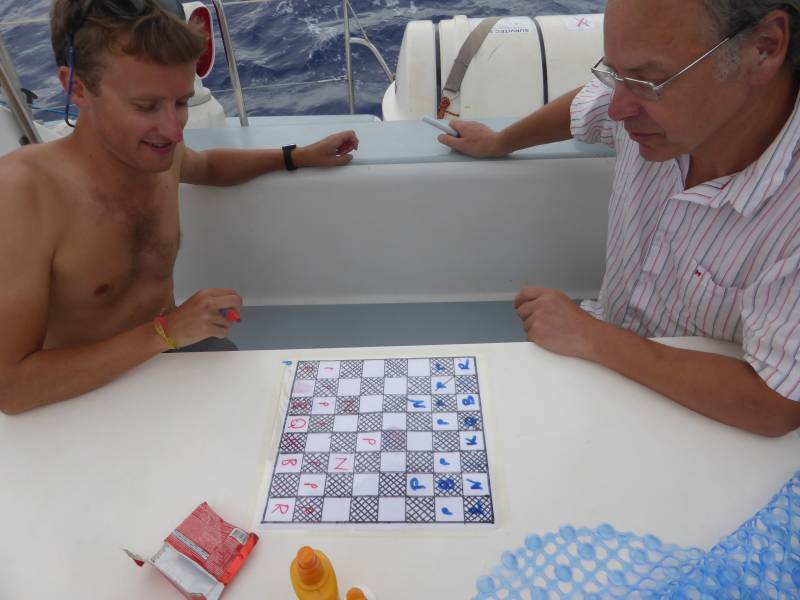
Generally the day was uneventful, just another day in paradise with a gorgeous sunset.
There is some community singing being planned for after dinner entertainment I believe…
Day 29 April 16
I have worked out the answer. What is the question? The question is “Why are we all finding it so easy to sleep in our bunks when at sea?” The answer to this lies in the rocking motion of the boat. How do you get babies to sleep? You rock them. It seems to work as well for us adults as for babies.
The wind was less today and it dropped through the morning. Just as I was settling down for an afternoon nap the sails were all furled and the boat stopped. Swimming time. Even in the gentle breeze the boat drifts so we float a long line with a buoy at the end just in case someone gets too far away. The stern of the boat opens out to give a great platform and a small ladder. It is easy to get back onto the boat.
If you want to feel the size of the ocean then swim a couple of times around the boat (20 metres long) in a gentle swell in four thousand metre deep water. I am not a very strong swimmer. The ocean felt vast. Anni has a GoPro camera so she could get some pictures when in the water.

Niall took the opportunity of calm weather to change the sheet on the Yankee. I have been calling this front sail a Genoa but I learn it is a Yankee because of it’s shape. A Genoa has the bottom of the sail close to the deck. A Yankee has the bottom of the sail cut away so you can see underneath it. The fishermen in Newfoundland used to have sails this shape – hence the name. Certainly, being able to see under the sail helps us to spot any dolphins or whales.
I have seen lots of flying fish in the past few days. They are fantastic fliers and can be airborne for twenty or thirty metres. They are rubbish at landing and have not perfected this aspect of flight yet. They must get tired and then just flop back into the water with a splash.
Day 30 April 17
It was another glorious sunset. Just as the sun was low on the horizon we spotted some dolphins. They were feeding and there were lots of them. Maybe forty or fifty and they were small. We were not sure what they were. We could not get too close to them, there were so many, they seemed to ignore us.
The scientific research on the boat is centred around dolphins and whales but members of the crew also take a keen interest in any birds we see. With either sets of animals lots of pictures are taken with a very long focus lens camera. Once the ‘sighting’ is over the photographs are pored over and examined carefully for clues to the animal in question. It is a much better system than trying to remember the details from memory.
The picture of the boat shows no person steering it. We have an automatic helm that steers the boat almost all of the time. In very windy and rough weather it sometimes cannot cope but for gentle sailing like today whoever is on watch (that’s me, I took the photograph) only has to keep a lookout ahead for any boats and to keep an eye on the wind direction and adjust the settings if the wind veers. There are a few other things to monitor, like fuel levels if we have the engine running or the state of the batteries.
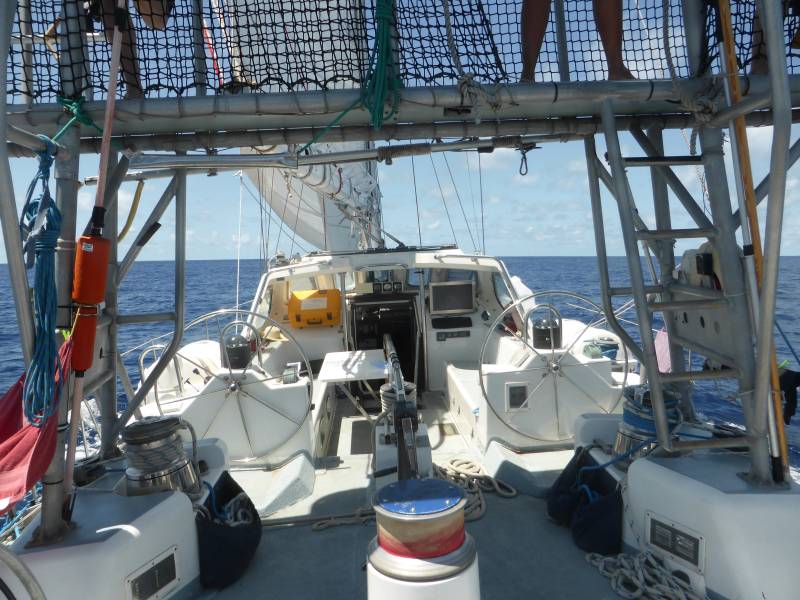
There is always someone on deck keeping an eye on things. In this photograph you can also see two pairs of legs on the frame above the deck. These people are looking out for whales / dolphins.
PS from Claire… Salvador is located very close to the continental shelf-edge, which means that the water gets very deep very close to the coast. For us, this has meant that the majority of our sail so far has been in very deep waters, often deeper than 5km. Whilst of course you do get oceanic dolphins, we haven’t been seeing them so far. Aside from a night-time visit to the boat and a single glimpse, today was the first time we have seen any properly since we left Brazil. Jack spotted a large group (around 80 animals) of dolphins associating with a “hurry” of feeding seabirds. Closer inspection revealed that they were Clymene dolphins. These small, agile dolphins are a deep water, oceanic species that isn’t often encountered on Song of the Whale, as we don’t survey as often in the warm waters that they favour. In fact, very little is known about their natural history or life history at all. They are very acrobatic, closely related to spinner dolphins, and they certainly didn’t disappoint this evening.
One of the nicest things about a voyage of this sort – aside of course from the cetaceans – is the variety of bird life that you encounter along the way. As someone who has worked extensively in the north Atlantic, but rarely gets to venture south of the equator, some of the birds seen on this trip have been a real treat. Today we were given a fly-by by a white-tailed tropic bird. These striking birds are found throughout the tropical mid-Atlantic and Caribbean. Characterised by long tail streamers, they make for an impressive sight.
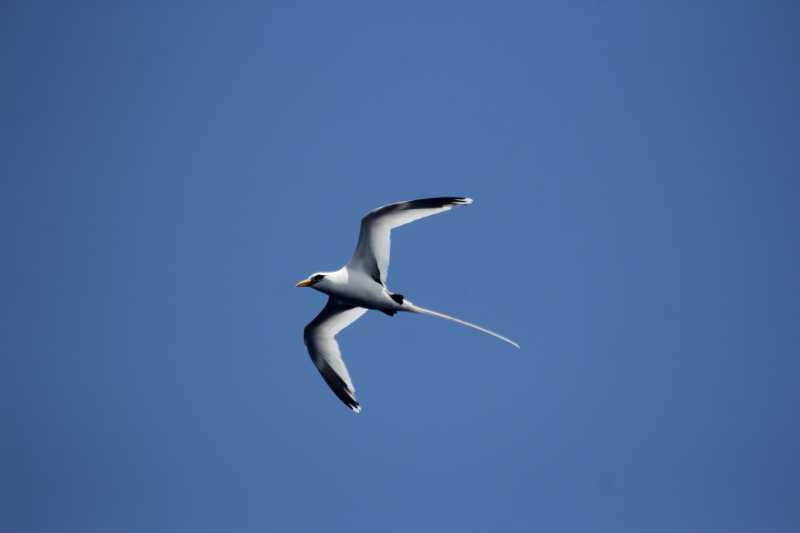
Day 31 April 18
Again at sundown yesterday we spotted some whales. These were pilot whales, a dozen or more spread out over an area a few hundred metres wide. They were so spread out we could not get too close to them and so good pictures were difficult to obtain. Then early this morning we spotted half a dozen sperm whales, again they were spread out. We motored near them watching them blowing. As they surface they exhale and produce a spray of water from their blowhole that reaches a couple of metres into the air. If you are close you can hear the sound of them exhaling. After half an hour they dived – lifting their flukes (rear fins) high in the air to help propel them downwards. They can remain submerged for over an hour.
Later in the morning Niall spotted a shark which rapidly disappeared from view.
The afternoon was a celebration of crossing latitude 0° – the equator.
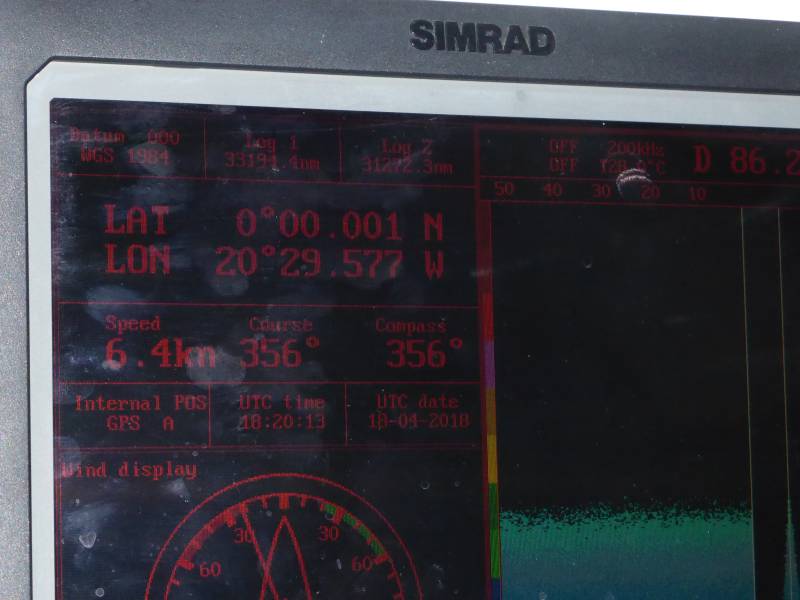
Hurrah, we are getting closer to home now. Will we see the North Star, Polaris tonight I wonder?
When we were exactly on the equator we stopped the boat and went for a celebratory swim. Some members have perfected the skill of jumping off the A-frame observation structure. There were lots of jumping into the water and swimming round and under the boat. We set off North again with the motor as the wind was dying.
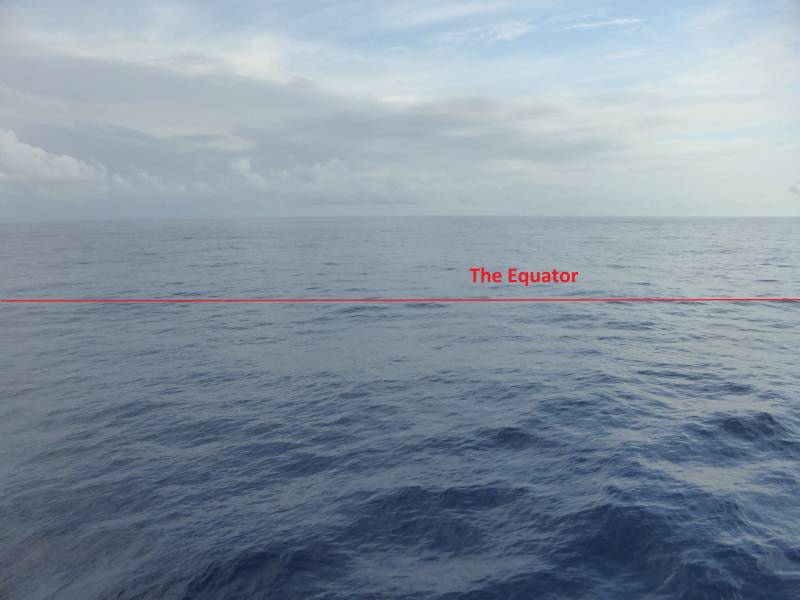
Last night we changed course from North East to North. We have been trying to head East to avoid the worst of the doldrums. We have now arrived at their southern edge and can turn North to head directly to our destination.
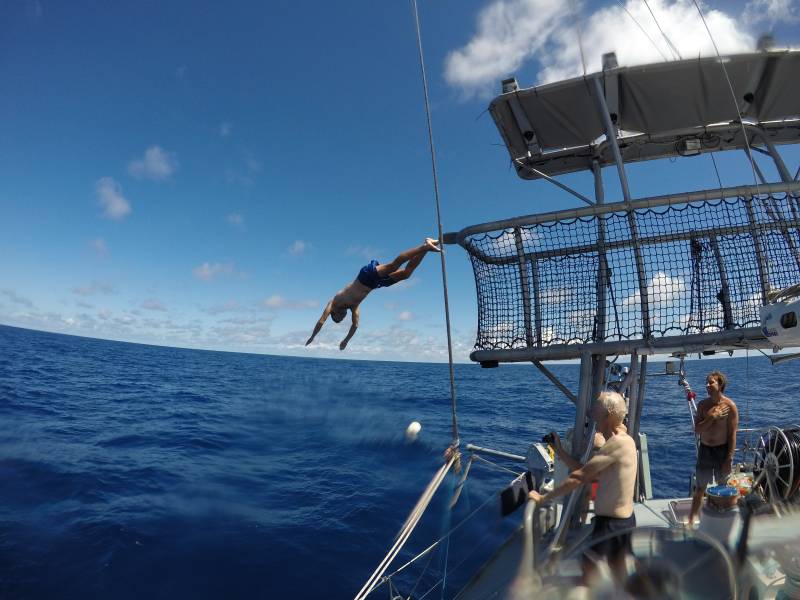
The wind has dropped tonight to 1 knot.
Shortly after setting off we were in the midst of more whales – these ones fairly small and were probably False Killer Whales. They look nothing like Killer Whales or Orca! It was as if our splashing had attracted them. They swam along with the boat for 20 minutes, some of them diving under the boat. The picture showing two whales above the surface also includes two below the surface. You can see the blowhole open on the top of them as they breathe. They were literally two metres aft of the boat.
A very good day.
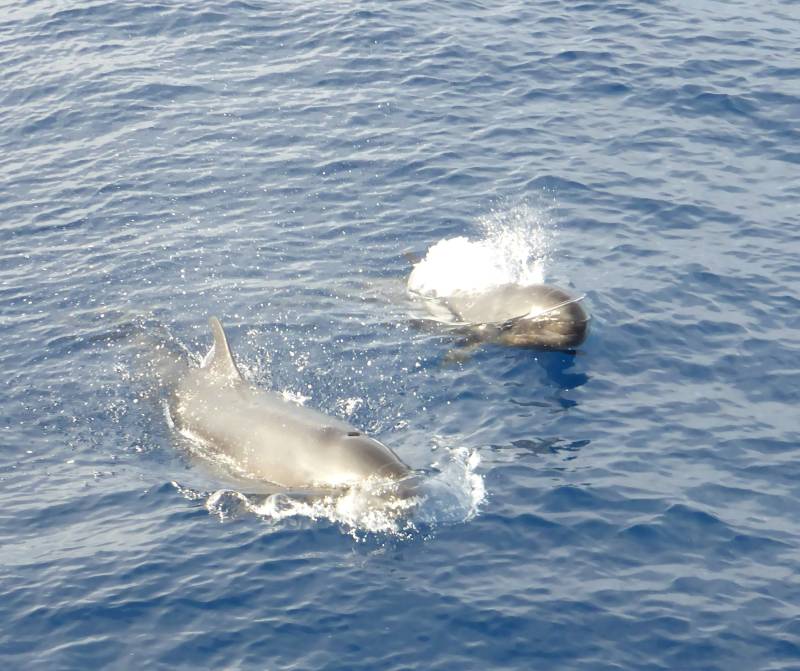
By Roger.
Sorry, comments are closed for this post.